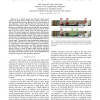Free Online Productivity Tools
i2Speak
i2Symbol
i2OCR
iTex2Img
iWeb2Print
iWeb2Shot
i2Type
iPdf2Split
iPdf2Merge
i2Bopomofo
i2Arabic
i2Style
i2Image
i2PDF
iLatex2Rtf
Sci2ools
ICRA
2008
IEEE
2008
IEEE
Target-directed attention: Sequential decision-making for gaze planning
— It is widely agreed that efficient visual search requires the integration of target-driven top-down information and image-driven bottom-up information. Yet the problem of gaze planning – that is, selecting the next best gaze location given the current observations – remains largely unsolved. We propose a probabilistic system that models the gaze sequence as a finite-horizon Bayesian sequential decision process. Direct policy search is used to reason about the next best gaze locations. The system integrates bottom-up saliency information, top-down target knowledge and additional context information through principled Bayesian priors. This results in proposal gaze locations that depend not only the featural visual saliency, but also on prior knowledge and the spatial likelihood of locating the target. The system has been implemented using state-ofthe-art object detectors and evaluated on a real-world dataset by comparing it to gaze sequences proposed by a pure bottomup saliency...
Gaze | Gaze Locations | Gaze Sequences | ICRA 2008 | Robotics |
| Added | 30 May 2010 |
| Updated | 30 May 2010 |
| Type | Conference |
| Year | 2008 |
| Where | ICRA |
| Authors | Julia Vogel, Nando de Freitas |
Comments (0)

